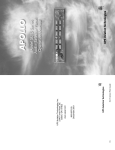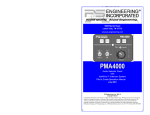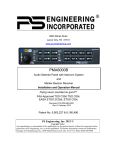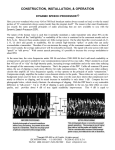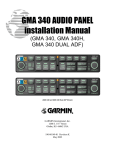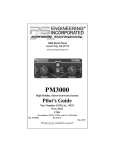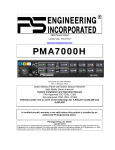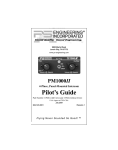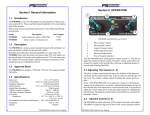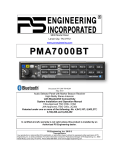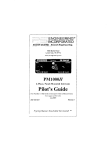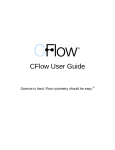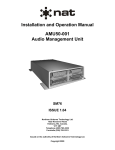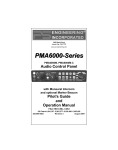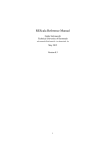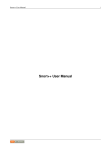Download Operation Manual
Transcript
9800 Martel Road Lenoir City, TN 37772 www.ps-engineering.com PMA6000B Audio Control Panel Marker Beacon and Intercom Pilot’s Guide and Operation Manual FAA-TSO C50c, C35d EASA ETSO C50c, 2C35d US Patent 4,941,187: 5,903,277: 6,160,496: 6,493,459 202-066-0200 Revision 1 February 2010 PMA6000B Pilot Guide 202-066-0200 1 OPERATION This section provides detailed operating instructions for the PS Engineering PMA6000B, Audio Selector Panel/Intercom Systems. Please read it carefully before using the equipment so that you can take full advantage of its capabilities. This guide is divided into sections covering the basic operating areas of the PMA6000B systems. They are: Audio Selector, Audio Selection, Intercom, and Marker Beacon Receiver (if equipped). Power, Fail Safe Operation (1) Unit power is turned on and off by pressing the unit Volume control knob (smaller concentric knob on left side of unit) In the OFF or "FAILSAFE" position, the pilot is connected directly to Com 1 an unswitched input #1, allowing transmit receive and alert capability regardless of unit condition. Any time power is removed or turned OFF, the audio selector will be placed in the fail-safe mode. In fail-safe mode, the pilot headset is connected directly to Com 1. Volume Control (2) The volume control knob adjusts the loudness of intercom in all headphones, pilot, copilot, and passenger. It has no effect on selected radio audio or music levels. Many general aviation headsets have a built-in 2 202-066-0200 February 2101 volume control, so volume can be reduced “locally.” It has no effect on external music input volume Audio Selector (3) Through the use of ten, push-button, back-lit switches, it is possible to select any or all receiver audio. When selected, a green LED in the button will illuminate indicating which audio source is selected. You will always hear the audio from the transceiver that is selected by the two push-button mic selector switches. The users can identify which receivers are selected by noting which push-button switches are illuminated. Push buttons labeled Nav l, Nav 2, DME, MKR (Marker), ADF, AUX (auxiliary), and SPR (Speaker) are momentary type switches. Press the switch again and it will be in the "off" position and remove that receiver from the audio. While selected, the switch will also be annunciated by an internal LED. NOTE: In Split Mode, no pushbuttons will be active. The only audio selected is from Com 1 and Com 2, as indicated by their respective lamps. Transmitter Selector (4) To select a radio for transmission, push the lower button in the Com selection section (XMT). Both the pilot and copilot have transmit capabilities on the selected transceiver. All hear the selected audio if the intercom is in the ALL mode. Only the person who presses their Push To Talk (PTT), will be heard over the aircraft radio. The PMA6000B has an automatic selector mode. Audio from the selected transceiver is automatically heard in the headsets and speaker (when selected). You can check this function by switching from COM 1 to COM 2 and watch the selected audio light on the selector change from Com 1 to Com 2. This ensures the pilot will never transmit on a radio that he is not listening to. When switching the mic selector from COM 1 to COM 2, while COM 2 audio had been selected, Com 1 audio will continue to be heard. This eliminates the pilot having to switch Com 1 audio back on, if desired. PMA6000B Pilot Guide 202-066-0200 3 When switching from COM 1 to COM 2 while Com 2 has NOT been selected, Com 1 audio will be switched off. In essence, switching the mic selector will not effect the selection of Com audio. Speaker Amplifier (5) The "SPR" in the audio section stands for speaker. This switch will place all selected audio on the cockpit speaker when selected. NOTE: with the exception of unswitched unmuted inputs, the speaker amplifier is not active in the "Split Mode." To reduce power consumption and internal heat buildup in the avionics stack, switch off the speaker amplifier when not in use. Swap Mode (Switch from Com 1 to Com 2 remotely) With a yoke mounted, momentary switch, the pilot can change from the current Com transceiver to the other by depressing this switch. When "Swap Mode" is active, the COM transmit and receive indicators will toggle to the other Com. To cancel "Swap Mode," the pilot may either press the yoke mounted switch again, or push the other com selector. Split Mode Pushing both Com 1 and Com 2 XMT buttons at the same time puts the PMA6000B into "Split Mode". This places the pilot on Com 1 and the copilot on Com 2, and they can use their respective radios independently. The passengers will not hear the radios or crew intercom in the split mode. An example of this useful feature is when the pilot may want to talk to Air Traffic Control, while the copilot may be speaking to Flight Watch. Placing the pilot on Com 2 and the copilot on Com 1 is not possible. Note: Due to the nature of VHF communications signals, and the size constraints in general aviation aircraft, it is probable that there will be some transmission bleedover in the Split mode, particularly on adjacent frequencies. PS Engineering makes no warranty about the suitability of Split Mode in all aircraft conditions. 4 202-066-0200 February 2101 Note: In all PMA6000B, Split Mode turns off all other (Nav, ADF, etc.) selected audio to copilot, who hears only COM 2. Pilot and copilot have intercom capability, placing the intercom in ISO mode will disable the pilot-copilot intercom. Passengers still have inter- com capability among themselves. Intercom Operation Adjusting the VOX-Squelch control (6) The PMA6000B provides a single VOX squelch control for the pilot, copilot and the passengers, although each microphone has it’s own squelch circuit, and only a microphone spoken into will be open. Since the number of microphones open at any one time is reduced, the amount of background noise is diminished. With the engine running, set the VOX control knob (Outer concentric knob) by slowly rotating the SQL control knob clockwise until you no longer hear the engine noise in the headphones. When the microphone is positioned properly near your lips, normal speech levels should open the channel. When you have stopped talking, there is a delay of about ½ second before the channel closes. This helps prevent choppy communications. Intercom Modes (6) The ICS switch is a 3-function mode selector that allows the pilot to tailor the intercom function to best meet the situation. The description of the intercom mode function is valid only when the unit is either in the COM 1 or COM 2 position of the Mic Selector switch. When the unit is in the "Split" mode, only the passengers have intercom function. Pushing the ICS button cycles the intercom through the three modes. ISO: (Top ): The pilot is isolated from the intercom and is connected only to the aircraft radio. He will hear the aircraft radio reception (and sidetone during radio transmissions). Copilot and passengers will hear the intercom and music on Entertainment 1, PMA6000B Pilot Guide 202-066-0200 5 but not the aircraft radio receptions or pilot transmissions. ALL: (Middle ): All parties will hear the aircraft radio, intercom, and music from Entertainment input #1. However, during any intercom communications, the music volume automatically decreases when SoftMute™ is active. The music volume increases gradually back to the original level after communications have been completed. CREW (Lower ): Pilot and copilot are connected on one intercom channel and have exclusive access to the aircraft radios. They may also listen to Entertainment 1. Passengers can continue to communicate with themselves without interrupting the Crew and also may listen to Entertainment 2. Anytime the PMA6000B is in "Split Mode" the pilot and copilot do not have any intercom function. The passengers will maintain intercommunications. Soft Mute The “Mute” button controls the music muting circuits. This “Karaoke Mode” prevents the music muting when a sing-a-long is desired. "Soft Mute" mode controls both entertainment inputs. Intercom Mode Table Mod Pilot e Hears Copilot Hears Passenger Comments Hears ISO A/C Radio Copilot Pilot Sidetone Passengers (during radio Music 1 transmission) Copilot Passengers Music 1 This mode allows the pilot to communicate with the air traffic control without the copilot or passengers bothered by the conversations. Copilot and passengers can continue to talk and listen to music All Radios Sidetone Pilot Copilot Passengers Music 1 Radios Sidetone Pilot Copilot Passengers Music 1 Radios Sidetone Pilot Copilot Passengers Music 1 This mode allows all on board to hear radio reception as well as communicate on the intercom. Music and intercom is muted during intercom and radio communications Crew Radios Sidetone Pilot Copilot Music 1 Radios Sidetone Copilot Pilot Music 1 Passengers Music 2 A second music source is automatically enabled for the passengers 6 202-066-0200 February 2101 Entertainment Input The audio selector panel has provisions for up to two separate entertainment input devices. Which device is heard is determined by the intercom modes witch located in the intercom section of the audio panel. (See Table 1 for overview.) While in the ISO (Isolate) mode, only the copilot and the four passengers will hear entertainment device #1. In normal operation, whenever a person speaks, the music will automatically mute and then will gradually return to the original listening level when the radio or intercom activity ceases. When in the ALL mode, all parties will hear the entertainment input #1. While in the CREW mode, pilot and copilot will hear entertainment input #1 while the passengers may listen to entertainment input #2. It is also possible to use only one entertainment input device for both entertainment inputs (1 and 2). A switch (DPDT) should be installed between the single entertainment device and entertainment input #1. This will allow the pilot and copilot decide if they hear entertainment while in the Crew mode. Marker Beacon (7) The Marker Beacon Receiver included in the PMA6000B uses visual and audio indicators to alert you when the aircraft passes over a 75 MHz transmitter. The Blue lamp, labeled "O," is the Outer Marker lamp and has an associated 400 Hertz 'dash' tone. The lamp and tone will be keyed at a rate of two tones/flashes per second when the aircraft is in the range of the Outer Marker Beacon. The Amber lamp, labeled "M," is the Middle Marker lamp and is coupled with a 1300 Hertz tone. It is keyed alternately with short 'dot' and long 'dash' bursts at 95 combinations per minute. The White lamp, labeled "I” is the Airway/Inner marker and has a 3000 Hertz 'dot' tone. The lamp and tone will be keyed at a rate of six times per second. The audio from the Marker Beacon Receiver can be heard by selecting the "M" push-button switch. Use "HI" sensitivity initially. This allows you to hear the outer marker PMA6000B Pilot Guide 202-066-0200 7 beacon about a mile out. Then touch the smaller MKR button to switch into Low Sensitivity mode. “LO” sensitivity gives you a more accurate location of the Outer Marker. Holding the MKR button for one second activates marker test lamp, labeled "T/M" and illuminates all three lamps simultaneously to assure the lamps (internal and external) are in working order. Releasing the button returns to the last sensitivity. Pressing the marker mode select (“T/M”) for one second will also cause the marker audio to mute for that beacon. The next beacon received will re-activate the audio. . 8 202-066-0200 February 2101 Warranty and Service In order for the factory warranty to be valid, the installations in a certified aircraft must be accomplished by an FAA- certified avionics shop and authorized PS Engineering dealer. If the unit is being installed in an experimental aircraft by the owner/builder, a factory-made harness must be installed for the warranty to be valid. PS Engineering, Inc. warrants this product to be free from defect in material and workmanship for a period of one (1) year from the date of sale. During the twelve (12) months of this 1-year warranty period, PS Engineering, Inc., at its option, will send a replacement unit at our expense if the unit should be determined to be defective after consultation with a factory technician. This warranty is not transferable. Any implied warranties expire at the expiration date of this warranty. PS Engineering SHALL NOT BE LIABLE FOR INCIDENTAL OR CONSEQUENTIAL DAMAGES. This warranty does not cover a defect that has resulted from improper or unreasonable use or maintenance as determined by us. This warranty is void if there is any attempt to dissemble this product without factory authorization. This warranty gives you specific legal rights, and you may also have other rights which may vary from state to state. Some states do not allow the exclusion of limitation of incidental or consequential damages, so the above limitation or exclusions may not apply to you. Factory Service The unit is covered by a 1-year limited warranty. See warranty information. Contact PS Engineering, Inc. at (865) 988-9800 or www.ps-engineering.com/support.shtml before you return the unit. This will allow the service technician to provide any other suggestions for identifying the problem and recommend possible solutions. After discussing the problem with the technician and you obtain a Return Authorization (RMA), ship product to: Service Department PS Engineering, Inc. 9800 Martel Rd Lenoir City, TN 37772 (865) 988-9800 FAX (865) 988-6619 Email: [email protected] Note: PS Engineering will not be responsible for units shipped using US Mail. Units that are received without an RMA number, or a detailed description of the problem and a contact phone number will be refused. PMA6000B Pilot Guide 202-066-0200 9 This page intentionally left blank 10 202-066-0200 February 2101 This page intentionally left blank PMA6000B Pilot Guide 202-066-0200 11 Record PMA6000B Serial Number: _________________ Date of Purchase: _________________________ Installed by: _____________________________ PS Engineering, Inc. 2009 © Copyright Notice Copyrighted information in this manual is subject to change without notice. PS Engineering reserves the right to improve or change the products or contents of this manual, without notification of any person or agency. The contents of this pilot’s guide may be downloaded, stored and reprinted for personal use provided that this copyright information is included. Commercial use is strictly prohibited. For further information contact the Publications Manager at PS Engineering, Inc., 9800 Martel Road, Lenoir City, TN 37772. Phone (865) 988-9800 12 202-066-0200 February 2101












